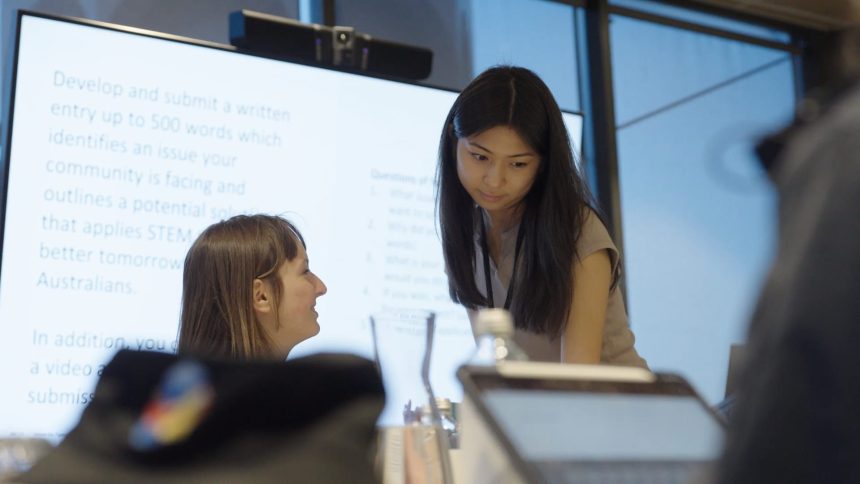A nationwide competition is calling on the next generation of young Australian innovators and problem-solvers to use their creative, critical thinking, collaborative, and communication skills to create solutions that address the issues they are most passionate about using STEM skills – and entries are closing soon.
Samsung’s Solve for Tomorrow initiative invites young Australians to submit a 500-word proposal, outlining the issues facing their community and how they would use STEM to solve it.
Up for grabs is the chance to win $10,000, and various Samsung tech prizes.
The competition offered a first for Australian students – enabling them to participate in a series of in-person Design Sprints in partnership with the student advocacy organisation Student Edge. The Design Sprints – that involved break-out time built into the sprint which facilitates teamwork, collaboration, and deep-focus work – have helped potential Solve for Tomorrow participants brainstorm, shape, and present their ideas.
Design thinking develops resilience
‘Design Thinking’ is a process that is used frequently by students, teachers, companies, and governments around the world, and can help people lead team-based design projects with confidence. This method helps students develop problem-solving skills and resilience, as they learn to embrace obstacles as part of the learning process and centre empathy and user experience in their approach. Design thinking’s hands-on, interdisciplinary, and real-world relevance can also contribute to more meaningful and engaging education, improving student participation and academic achievement.
All ideas explored with the Design Sprint process received immediate entry into the Solve for Tomorrow competition. But although the fourth and final Design Sprint was held on 8 November exclusively for Student Edge members – there is still an opportunity for students passionate about positive change to bring their ideas to life and make an impact.
In the lead-up to the competition submission deadline on 7 January 2024, Director of Corporate Marketing at Samsung Australia Brett Turnbull, hopes the story of the engineering student from Tasmania who won the 2021 grand prize – can offer inspiration to interested entrants.
How roadkill inspired an award-winning engineering idea
For Meg Philips, growing up with the knowledge that Tasmania is the roadkill capital of the world motivated the nature-loving engineering student to look for a solution that would help save the lives of iconic wildlife – and reduce the economic impact the problem creates.
Her entry in the 2021 Solve for Tomorrow competition showcased her ground-breaking idea to help prevent roadkill on Tasmanian roads by using radio signals and sensors to essentially warn animals of oncoming vehicles and help save their lives.

When she was announced as the winner in January 2022, Ms Philips said she was “thrilled to have won”.
“I’ve lived in Tasmania my whole life so it’s no surprise that I am an animal lover. Working with wireless communication led me to applying RFID between cars and animals. It feels so rewarding to have my years of hard work empower me to make functional and viable solutions to real-world problems. The prize money will go towards developing an improved prototype and working on feasibility. Watch this space!”
Empowering young Australian to channel their STEM skills
“The first Solve for Tomorrow competition launched locally in 2021, following the initial U.S. launch in 2010,” Mr Turnbull told EducationDaily. “This year’s competition marks the second rollout of the Australian edition of Solve for Tomorrow, which is designed to empower young Australians aged 14-24 to channel their STEM skills into projects that address their biggest concerns. The initiative aligns with Samsung’s unwavering commitment to education and fostering a passion for learning among young people. It provides an exciting opportunity for participants to apply their STEM knowledge in practical and impactful ways. At a time when Australian jobs in STEM are predicted to grow by over approximately 14.2 per cent by 2026, young Australians have an incredible opportunity to develop their STEM skills to enact positive change.”
The principle underpinning Design Thinking, he says, “is human-centred in nature, and a powerful problem-solving practice”.
“It uses processes and tools from the design world to make creative leaps in the real world. By adopting a Design Thinking mindset, we can better identify creative solutions to abstract problems at any scale and shape positive change in local communities, no matter our background, experience, or interests.”
Creativity at the heart of tech-led innovation
Personally, Mr Turnbull says his favourite part of viewing competition entries is the creativity displayed by the students involved.
“I was blown away by the 2021 competition entries and the thought behind them. I’m looking forward to seeing what problems young Australians are looking to solve as an indicator of what issues matter most to them. We know that Gen Z is more concerned about social impact than previous generations and they’re proactive about making a difference,” he told EducationDaily.
“Sustainability continues to be a passion topic among Gen Z, and previous Solve for Tomorrow participants submitted thought-provoking ideas that address environmental issues and how we can create more sustainable communities. We know that issues pertaining to sustainability as well as those surrounding mental health and equality are particularly concerning for young people and I’m looking forward to seeing how the next generation of Australian innovators can tackle these challenges. “
With Australian educators tasked with supporting tech-driven learning for a new generation of leaders, Mr Turnbull says “Australia’s education sector faces challenges with educator shortages and declining teaching graduate numbers, putting pressure on administrators, principals, and teachers to enhance academic outcomes”.
“To alleviate these challenges, many schools are embracing educational technology (edtech), with about 40 per cent aiming to accelerate their tech strategies in the short to medium-term. Samsung is a strong believer that technology can enable an engaging hybrid digital learning experience inside the classroom and beyond to deliver better educational outcomes – understanding the importance of fostering innovative thinkers. The future of Australian education lies in this synergy between traditional teaching methods and innovative technology.”









